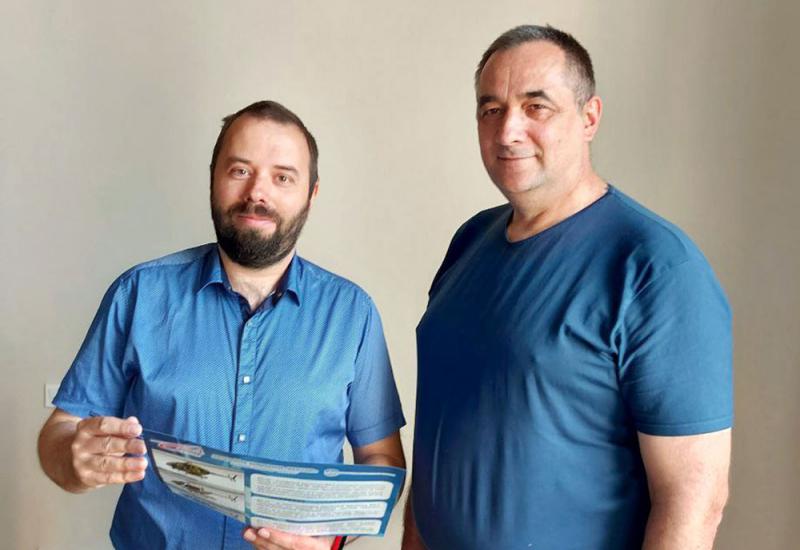This year in early May, Innovation Holding "Sikorsky Challenge" and Aviation Company VEKTOR LLC signed a Memorandum of Cooperation. So, now one of the high potential start-ups supported by the Innovation Holding "Sikorsky Challenge" is the implementation of a project on development and commercialization of the light utility helicopter VM-4 " Jmil " on the basis of Aviation Company VEKTOR LLC.
The correspondent of “Kyiv Polytechnic” discussed issues of the implementation of this business-oriented project, and flying qualities and performances of the helicopter with the director of the Innovation Holding "Sikorsky Challenge" Oleksii Anatoliyovych Strutsynskyi and the commercial director of Aviation Company VEKTOR LLC Egor Andriyovych Shyshenok. After all, this project has scientific and applied significance in the revival of development and production potential of Ukraine in the field of aircraft construction and in the further development of the direct manufacturer of complex aircraft.
According to Oleksii Strutsynskyi, due to attracting certain funds from potential investors for the production of "Jmil", today it is possible to plan the release of a prototype of the VM-4 helicopter, on the basis of which a modification of a military helicopter will be created. Light attack aircraft VM-4V "Cyborg", naval and border patrol helicopter with certain design innovations can be used as reconnaissance, landing, anti-submarine aircraft or as a means of communication or electronic warfare with the enemy.
Egor Shyshenok talks about the significant prospects of small aircraft. For example, today the creation of a medical modification of the VM-4 helicopter is within the power of Aviation Company VEKTOR LLC. The machine can be used for medical evacuation, delivery of small shipments (medicines, equipment, etc.). The “Jmil” helicopter can also be useful for police and security services. After all, it can be used to patrol cities, hard-to-reach areas, to transport Special Forces.
And what about the design and operating features of the "Jmil"? The light multi-purpose four-seater helicopter, in contrast to foreign counterparts, will have two piston engines manufactured by ULPower (Belgium). The capacity of each of them is 145 horsepower. Avionics - electronic systems designed for use on aircraft - will come from the company "Garmin" (USA). Depending on the type of engines, the helicopter will be able to use motor gasoline brands A-95, A-98, A-100. The maximum achievable speed of the aircraft (with a takeoff mass of 1000 kg) will be 230 km/h. And cruise speed will be 200 km/h. Flying range will be 550 km at a static ceiling of 1500 m. It is assumed that the fuselage made of modern composite materials will be a significant advantage of the "Jmil" over all existing counterparts in this class of helicopters.
In the future, the development of a heavier, five-seater helicopter with two engines (to compensate engine thrust in case of casualty of one of them) and the development of light helicopters using a hybrid rotorcraft propulsion. Thus, it is possible to compete with the current analogue of foreign helicopters, as they say, in terms of performance and reliability.
Regarding the readiness of this project for implementation, the interlocutors have a common view. The fifth level of Technology readiness out of 9 possible - this is history. Today, the basic scientific principles that form the basis of new technology have been formed. The concept, the idea of the future technology of creation of "Jmil" and its application in the form of products are also formulated. And that's not all. Laboratory experiments and laboratory demonstrations of the efficiency of the technology were carried out, which is the basis of the project. Also in the laboratory, the first prototype of a helicopter was demonstrated, which proved that chosen technology is operational. Testing of components of assembly units for the full-size model is developed and carried out.
What is left? Development and production of a prototype for demonstration in the operation environment. Next, tests should be carried out to demonstrate efficiency in real conditions. That's when the "Jmil" will be ready to sail. The test program will allow us to create appropriate documentation for full production. Finally, at the TRL 9, the helicopter will work in real conditions, and full-scale production will be started. And as merchants say, you can put a decent price on the aircraft.
Suppose that funds come from the state budget or from private investors to build an experimental model of "Jmil". What's next? Preparation of technical documentation will take a year. Then modeling the first full-scale aircraft will take another year of intensive work of structural engineers and workers. Operation tests of the prototype sample of "Jmil" will also take no more than one year. Successful tests can start the production of a series of domestic helicopters. So, it is for investors to decide.
According to O. Strutsynskyi and E. Shyshenko, the issue of commercialization of the project is one of the main factors in the implementation of plans for the full production of helicopters. But you need not only investment, but also the advice of experienced consultants, which is often even more valuable than the financial component. In cooperation with the Innovation Holding ``Sikorsky Challenge", the staff of Aviation Company VEKTOR LLC will be able to involve graduates of the Education and Research Institute of Aerospace Technologies of Igor Sikorsky Kyiv Polytechnic Institute in the production process. So, the experienced team of Aviation Company VEKTOR LLC will be waiting for young inventors and researchers.
Life does not stand still. Cooperation between the Innovation Holding "Sikorsky Challenge" and Aviation Company VEKTOR LLC is gradually expanding. In particular, the process of preparing a joint patent for one of the elements of the “Jmil” is taking place right now; that is the patent for the helicopter emergency automatic stabilization system within the helicopter safety system.

